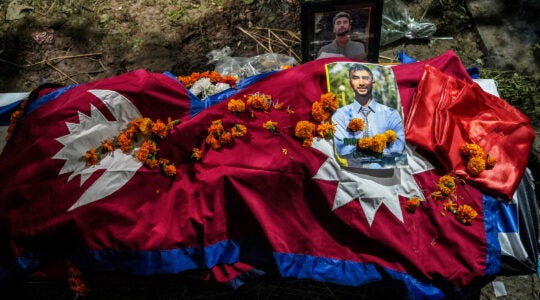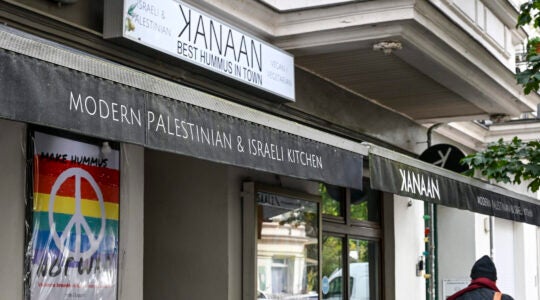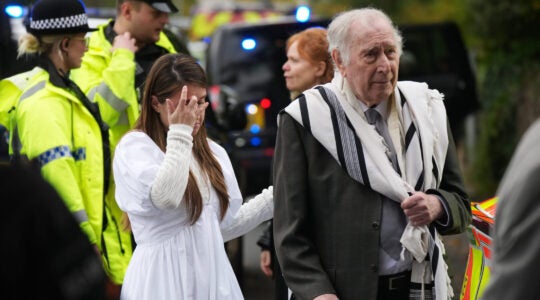
An Israeli staffer with IsraAid (on left) conducts a post-trauma recovery course with teachers in Wateri, Japan.
(Nofar Tagar for IsraAid.)

Teachers in Wateri, Japan, get a chance to work through the emotional effect of the devastating earthquake and tsunami in a post-trauma course run by IsraAid.
(Nofar Tagar for IsraAid.)
SAN FRANCISCO (JTA) — In northeastern Japan, the area hardest hit by the devastating March 11 earthquake and tsunami, a team of Israeli post-trauma experts guided local teachers and officials through their lingering pain.
One kindergarten teacher broke down in tears as she related how another teacher saw the great wall of water approaching her school and tried in vain to save her young pupils. Eight of the children were washed away, along with their valiant teacher.
“People were not aware how much the disaster affected them,” said Shachar Zahavi, the founder and executive director of IsraAid, a Tel Aviv-based nonprofit that is running post-trauma courses in the town of Watari, as well as providing other much-needed material and emotional aid in the region.
More than two months after the 9.0 magnitude earthquake and resultant tsunami destroyed thousands of homes, entire towns and countless lives in Japan, Jewish groups from North America and Israel continue to offer a helping hand to the Asian island nation.
“It’s not like the scene in Haiti,” said Zahavi, referring to the many international agencies, including several from Israel, that poured into the quake-stricken Caribbean island in 2010. “Most of the other agencies have left Japan by now. A lot of people, in Japan and Israel, are amazed we’re still there.”
The Jewish Federations of North America has raised more than $1 million for Japan. More than $800,000 has come from individual federations; the rest has been raised through donations to the parent organization. Most of the money is funneled through the American Jewish Joint Distribution Committee and its local agencies on the ground.
The JDC, the Home Front Command and Medical Corps of the Israel Defense Forces, and IsraAid all rushed to the scene of the disaster, offering emergency aid as well as ongoing help.
According to its communications director, Michael Geller, the JDC has raised $2.1 million for Japan aid. Much of it went to emergency supplies sent to the stricken region by foreign agencies, including Chabad, UNICEF and the International Rescue Committee. It also helped fund the IDF field hospital set up in Minamisanriku, a town in the Miyagi Prefecture where half of the 17,000 residents died in the tsunami.
The JDC is working through its partner agencies in Japan. With the American School there, the JDC bought desks and chairs for three schools in the city of Ishinomaki, and in tandem with Tokyo English Life Line is providing psycho-social support services and training to mental health professionals who work with children and the elderly. Geller said that more than 100 people will be trained by mid-June.
When the IDF medical corps pulled out of Japan in early April after treating 234 patients in its field hospital, it left behind more than healed bodies.
At the request of local officials, the Israelis left much of the specialized medical gear they had brought, including X-ray, ophthalmologic, orthopedic and ENT equipment, as well as surgical coats, syringes, bandages and other material supplies.
The team also donated the six prefabricated buildings it had set up for its field clinic, which has become the area’s main medical center, said Col.Ofir Cohen-Marom, an ob-gyn from Assaf Harofeh Hospital and the deputy to the IDF’s chief medical officer.
“We were the only foreign medical delegation in Japan,” Cohen-Marom told JTA, explaining that usually only Japanese physicians are permitted to treat the Japanese population.
At first the Israeli team was escorted by medical personnel from Japan’s Foreign Ministry, he said, presumably to make sure that they were providing proper care. Within a few days, however, the locals and the Israelis were working together, consulting on the same patients.
“It was hard to leave this suffering population after 2 1/2 weeks,” Cohen-Marom said. “It makes me happy to see they’re using the supplies and medical center we left behind. We really did a great thing.”
Marom-Cohen estimated that it will take up to three years for the region to rebuild, including constructing a new hospital. During that time, he said, the locals will continue to use the Israeli clinic and equipment.
IsraAid still has three or four staffers working in Japan, said Zahavi. The organization rehabilitated two kindergartens and distributed toys and school supplies to children via six shelters in Watari, Yamamoto and Sendai, and completed a 10-day post-trauma course for some three dozen teachers in Watari.
It’s the post-trauma help that is most unique, Zahavi told JTA.
Israel’s lengthy experience with war and terrorism, he explained, makes it particularly qualified to offer the fruits of that knowledge to others. In Japan, where emotions are not typically displayed publicly, the teachers seemed grateful for the help, and the organization is receiving much support from the local community and government officials.
“It’s the first time these people have gone through post-trauma sessions where they could share their individual experiences and talk about their feelings,” Zahavi said. “There was a lot of crying, a lot of emotion.
“But it’s not just about talking — we teach how to express feelings through touch, drawing and writing as well. That was new for them.”
IsraAid will offer another course in June with a broader focus, he said.
As with the other Jewish aid to Japan, what’s noteworthy is the partnership between Israeli and North American Jewish communities, Zahavi points out. IsraAid’s emergency relief program in Japan is supported and funded by the Jewish federations of Toronto, Chicago, Miami, Los Angeles and Washington, D.C., as well as the JFNA, the American Jewish Committee and B’nai B’rith International.
“This is something that the Jewish people is giving, not just Israel,” he said.
JTA has documented Jewish history in real-time for over a century. Keep our journalism strong by joining us in supporting independent, award-winning reporting.





